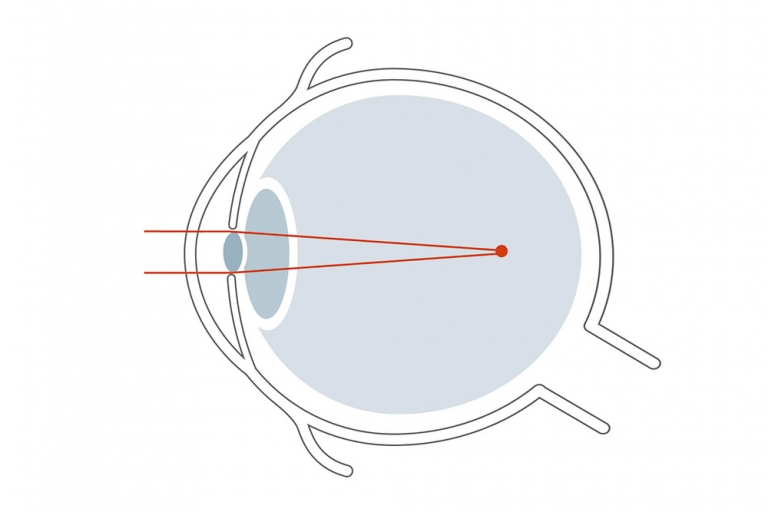Refractive errors
Nearsightedness, farsightedness, astigmatism, or presbyopia are often genetically determined or a result of the natural aging process. However, sudden changes in vision require a more comprehensive evaluation.

Normal eye
We speak of normal vision when the cornea and lens focus the light exactly onto the yellow spot ('macula'), the point of sharpest vision on the retina ('focal point'). Through a stronger or weaker curvature of the lens ('accommodation'), which leads to an increase or decrease in refractive power, objects can be seen sharply both near and far.


Nearsightedness (Myopia)
In a nearsighted eye, either the refractive power of the lens is too high or the eyeball is too long. As a result, the focal point of the light rays lies in front of the retina. Distant objects, such as traffic signs, are therefore perceived as blurry and indistinct, while nearsighted people can often see clearly up close.
Nearsightedness can be corrected with glasses or contact lenses. The lenses (so-called diverging lenses) reduce the excessive refractive power of the cornea by a certain amount ("negative refractive power"), so that the light rays are again focused on the point of sharpest vision on the retina. Therefore, glasses for nearsighted people are also called "minus lenses". The measure of the refractive power of these lenses is given, for example, as "-2 diopters".
Laser eye surgery is another option for correcting nearsightedness. Especially for people who do not want to or cannot wear glasses or contact lenses.
Hyperopia (Farsightedness)
In a farsighted eye, the refractive power of the lens is too weak or the eyeball is too short. As a result, the light rays are focused behind the retina. Farsighted people can often see well into old age at a distance; however, they tend to hold books and magazines at arm's length because closer objects appear blurry to them.
Unlike in nearsightedness, hyperopia can be compensated to a certain extent by an increased curvature of the lens ("accommodation").

Only with very strong hyperopia do people need to wear glasses from a young age, as the refractive power of the lens can only be increased to a limited extent. With age, the elasticity of the lens decreases, and thus its ability to change shape. Therefore, farsighted people need reading glasses earlier in life than normal-sighted or nearsighted people. In old age, glasses for distance vision are also required, as the elasticity of the lens has decreased so much that a sharp image can no longer be produced even for distant objects.
Hyperopia can be corrected with glasses or contact lenses. The lenses (so-called converging lenses) increase the insufficient refractive power of the cornea and lens. The measure of the increased refractive power of these lenses is given, for example, as “+2 diopters”.
Laser eye surgery is another option for correcting hyperopia.

Astigmatism
In addition to nearsightedness or farsightedness, a condition known as astigmatism is often present. It is caused by an irregular curvature of the corneal surface, which results in a distorted image on the retina. For example, a point is not imaged as a point but as a small line or streak.
Astigmatism can also be corrected with glasses or contact lenses. The glasses consist of specially ground cylindrical lenses that refract incoming light rays in such a way that they are again imaged as a point on the retina. Laser eye surgery is also an option.
Presbyopia
The lens behind our pupil changes shape to focus at different distances. This process, called accommodation, causes the lens to change from a flat shape for distance vision to a curved shape for near vision. With age, the lens loses its ability to accommodate, and presbyopia occurs. Presbyopia affects everyone and significantly impairs near vision from the age of 40. Even those who have never needed glasses before will experience problems with reading, close-up work, reading a watch, or reading text messages.
At the Regensburg Eye Clinic, we can offer you various options (from reading glasses or progressive lenses to lens implants) to improve your near vision.
Surgical Procedures for the Correction of Refractive Errors
Today, there are various surgical procedures for the correction of nearsightedness, farsightedness, and astigmatism. These surgeries are referred to as refractive surgery. The most well-known is the LASIK procedure, in which refractive errors are treated with lasers. However, there are also many other surgical procedures that we perform at the Regensburg Eye Clinic to correct different types of vision problems.

